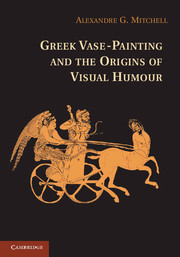Book contents
- Frontmatter
- Epigraph
- Contents
- List of Illustrations
- List of Tables
- Preface
- Acknowledgements
- Abbreviations
- GREEK VASE-PAINTING AND THEORIGINS OF VISUAL HUMOUR
- One Introduction
- Two Humour in the City
- Three Humour in the City
- Four Satyrs and Comic Parody
- Five Caricatures inAthens and at the Kabirion Sanctuary in Boeotia
- Six Conclusion
- Glossary
- Bibliography
- Index of Vases Cited in the Text
- General Index
Six - Conclusion
Vases, Humour, and Society
Published online by Cambridge University Press: 05 January 2014
- Frontmatter
- Epigraph
- Contents
- List of Illustrations
- List of Tables
- Preface
- Acknowledgements
- Abbreviations
- GREEK VASE-PAINTING AND THEORIGINS OF VISUAL HUMOUR
- One Introduction
- Two Humour in the City
- Three Humour in the City
- Four Satyrs and Comic Parody
- Five Caricatures inAthens and at the Kabirion Sanctuary in Boeotia
- Six Conclusion
- Glossary
- Bibliography
- Index of Vases Cited in the Text
- General Index
Summary
In this concluding chapter, a number of discussions are regrouped under two main headings. The first is centred on vases, painters, and iconography, and the second on humour and social cohesion. The first discussion is partly based on querying an extensive database of comic vases, which I developed during my doctoral research, from different angles. For example, the comparison between comic scenes depicted in Athenian black-figure to those in Athenian red-figure. Why are some scenes found more often or are rarer than others? Are some painters more interested in painting humorous scenes than others? Which types of vases present the most or least humorous scenes? Is there such a thing as regional humour? Iconography is then discussed, and a justification given for establishing a future theory of visual humour. I shall also briefly discuss what I have coined ‘visual immediacy’. The second part contains a series of discussions under the heading of humour and social cohesion. For some time, I had thought that only certain comic categories, such as parody, caricature, and situation comedy, were transposable in time and space from culture-to-culture. But there is at least one other fundamental aspect of humour that seems commonplace among most cultures – and that is the need for humour as a channel for social cohesion.
It has been underlined on a number of occasions that humour gives us an insight into ancient Greek life, and that, for better or for worse, what we see is a mirrored vision of society. Let us see, then, in spite of all its distortions and aberrations, what humour reveals.
- Type
- Chapter
- Information
- Greek Vase-Painting and the Origins of Visual Humour , pp. 280 - 316Publisher: Cambridge University PressPrint publication year: 2009

